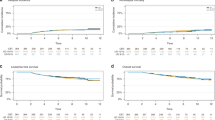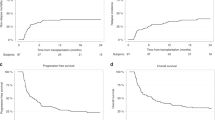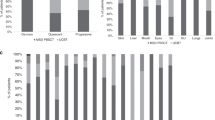Abstract
AML relapse remains the leading cause of transplant failure among Allo-SCT recipients. A single institution study was conducted on 348 patients with AML who received an Allo-SCT from an umbilical cord blood (UCB, 222) or HLA-matched-related (RD, 126) donor between 2000–2011. Relapse after Allo-SCT occurred in 72 UCB and 32 RD transplant recipients. Three patients achieved CR after withdrawal of immune suppression with no further therapy. Fifty-two patients received intensive post-relapse therapy, defined as systemic chemotherapy (22 UCB, 7 RD), second Allo-SCT (nine UCB, two RD), or DLI±systemic chemotherapy (0 UCB, 12 RD); of these, 25% achieved CR (21% UCB vs 35% RD, P=0.16). Survival at 1 year after relapse was 22% for all patients (19% UCB vs 28% RD, P=0.36). In multivariable analysis, post-relapse mortality was lower in patients receiving intensive therapy for relapse (hazard ratio (HR)=0.4; 95% confidence interval (CI) 0.2–0.6, P<0.01) and higher in patients with peripheral blood blasts above the median (HR=3.8; 95% CI 2.2–6.6, P<0.01), active infection (HR=1.9; 95% CI 1.0–3.5, P=0.05) and non-infectious medical complications (HR=2.0; 95% CI 1.2–3.5, P=0.01). In conclusion, patients with AML relapsing after Allo-SCT who were in good-enough clinical condition to receive intensive therapy had superior short-term survival.
This is a preview of subscription content, access via your institution
Access options
Subscribe to this journal
Receive 12 print issues and online access
$259.00 per year
only $21.58 per issue
Buy this article
- Purchase on Springer Link
- Instant access to full article PDF
Prices may be subject to local taxes which are calculated during checkout



Similar content being viewed by others
References
Schmid C, Labopin M, Nagler A, Niederwieser D, Castagna L, Tabrizi R et al. Treatment, risk factors, and outcome of adults with relapsed AML after reduced intensity conditioning for allogeneic stem cell transplantation. Blood 2012; 119: 1599–1606.
Devillier R, Crocchiolo R, Etienne A, Prebet T, Charbonnier A, Furst S et al. Outcome of relapse after allogeneic stem cell transplant in patients with acute myeloid leukemia. Leuk Lymphoma 2013; 54: 1228–1234.
Savani BN, Mielke S, Reddy N, Goodman S, Jagasia M, Rezvani K . Management of relapse after allo-SCT for AML and the role of second transplantation. Bone Marrow Transplant 2009; 44: 769–777.
Schmid C, Labopin M, Nagler A, Bornhauser M, Finke J, Fassas A et al. Donor lymphocyte infusion in the treatment of first hematological relapse after allogeneic stem-cell transplantation in adults with acute myeloid leukemia: a retrospective risk factors analysis and comparison with other strategies by the EBMT Acute Leukemia Working Party. J Clin Oncol 2007; 25: 4938–4945.
Thanarajasingam G, Kim HT, Cutler C, Ho VT, Koreth J, Alyea EP et al. Outcome and prognostic factors for patients who relapse after allogeneic hematopoietic stem cell transplantation. Biol Blood Marrow Transplant 2013; 19: 1713–1718.
Vardiman JW, Harris NL, Brunning RD . The World Health Organization (WHO) classification of the myeloid neoplasms. Blood 2002; 100: 2292–2302.
Vardiman JW, Thiele J, Arber DA, Brunning RD, Borowitz MJ, Porwit A et al. The 2008 revision of the World Health Organization (WHO) classification of myeloid neoplasms and acute leukemia: rationale and important changes. Blood 2009; 114: 937–951.
Grimwade D, Walker H, Oliver F, Wheatley K, Harrison C, Harrison G et al. The importance of diagnostic cytogenetics on outcome in AML: analysis of 1,612 patients entered into the MRC AML 10 trial. The Medical Research Council Adult and Children's Leukaemia Working Parties. Blood 1998; 92: 2322–2333.
Warlick ED, Tomblyn M, Cao Q, Defor T, Blazar BR, Macmillan M et al. Reduced-intensity conditioning followed by related allografts in hematologic malignancies: long-term outcomes most successful in indolent and aggressive non-Hodgkin lymphomas. Biol Blood Marrow Transplant 2011; 17: 1025–1032.
Brunstein CG, Barker JN, Weisdorf DJ, DeFor TE, Miller JS, Blazar BR et al. Umbilical cord blood transplantation after nonmyeloablative conditioning: impact on transplantation outcomes in 110 adults with hematologic disease. Blood 2007; 110: 3064–3070.
Brunstein CG, Fuchs EJ, Carter SL, Karanes C, Costa LJ, Wu J et al. Alternative donor transplantation after reduced intensity conditioning: results of parallel phase 2 trials using partially HLA-mismatched related bone marrow or unrelated double umbilical cord blood grafts. Blood 2011; 118: 282–288.
Cooley S, Foley B, Verneris MR, McKenna D, Luo X, Dusenbery KE et al. Haploidentical natural killer (NK) cells expanding In vivo after adoptive transfer exhibit hyperfunction that partially overcomes self tolerance and leads to clearance of refractory leukemia. Blood (ASH Annual Meeting Abstracts) 2011; 118: 355.
Oran B, Giralt S, Saliba R, Hosing C, Popat U, Khouri I et al. Allogeneic hematopoietic stem cell transplantation for the treatment of high-risk acute myelogenous leukemia and myelodysplastic syndrome using reduced-intensity conditioning with fludarabine and melphalan. Biol Blood Marrow Transplant 2007; 13: 454–462.
Porter DL, Alyea EP, Antin JH, DeLima M, Estey E, Falkenburg JH et al. NCI First international workshop on the biology, prevention, and treatment of relapse after allogeneic hematopoietic stem cell transplantation: report from the committee on treatment of relapse after allogeneic hematopoietic stem cell transplantation. Biol blood marrow transplant 2010; 16: 1467–1503.
Mortimer J, Blinder MA, Schulman S, Appelbaum FR, Buckner CD, Clift RA et al. Relapse of acute leukemia after marrow transplantation: natural history and results of subsequent therapy. J Clin Oncol 1989; 7: 50–57.
Warlick ED, DeFor T, Blazar BR, Burns L, Verneris MR, Ustun C et al. Successful remission rates and survival after lymphodepleting chemotherapy and donor lymphocyte infusion for relapsed hematologic malignancies postallogeneic hematopoietic cell transplantation. Biol Blood Marrow Transplant 2012; 18: 480–486.
Loren AW, Porter DL . Donor leukocyte infusions for the treatment of relapsed acute leukemia after allogeneic stem cell transplantation. Bone Marrow Transplant 2008; 41: 483–493.
Levine JE, Braun T, Penza SL, Beatty P, Cornetta K, Martino R et al. Prospective trial of chemotherapy and donor leukocyte infusions for relapse of advanced myeloid malignancies after allogeneic stem-cell transplantation. J Clini Oncol 2002; 20: 405–412.
Lee JH, Lee KH, Kim S, Seol M, Kim SH, Kim WK et al. Combination chemotherapy of intermediate-dose cytarabine, idarubicin, plus etoposide and subsequent mobilized donor leukocyte infusion for relapsed acute leukemia after allogeneic bone marrow transplantation. Leuk Res 2001; 25: 305–312.
Choi SJ, Lee JH, Lee JH, Kim S, Seol M, Lee YS et al. Treatment of relapsed acute myeloid leukemia after allogeneic bone marrow transplantation with chemotherapy followed by G-CSF-primed donor leukocyte infusion: a high incidence of isolated extramedullary relapse. Leukemia 2004; 18: 1789–1797.
Kedmi M, Resnick IB, Dray L, Aker M, Samuel S, Gesundheit B et al. A retrospective review of the outcome after second or subsequent allogeneic transplantation. Biol Blood Marrow Transplant 2009; 15: 483–489.
Kolb HJ, Schattenberg A, Goldman JM, Hertenstein B, Jacobsen N, Arcese W et al. Graft-versus-leukemia effect of donor lymphocyte transfusions in marrow grafted patients. Blood 1995; 86: 2041–2050.
Eapen M, Giralt SA, Horowitz MM, Klein JP, Wagner JE, Zhang MJ et al. Second transplant for acute and chronic leukemia relapsing after first HLA-identical sibling transplant. Bone Marrow Transplant 2004; 34: 721–727.
Vago L, Perna SK, Zanussi M, Mazzi B, Barlassina C, Stanghellini MT et al. Loss of mismatched HLA in leukemia after stem-cell transplantation. New Engl J Med 2009; 361: 478–488.
Acknowledgements
We would like to acknowledge Michael Franklin, MS, for assistance in editing this manuscript.
Author information
Authors and Affiliations
Corresponding author
Ethics declarations
Competing interests
The authors declare no conflict of interest.
Rights and permissions
About this article
Cite this article
Bejanyan, N., Oran, B., Shanley, R. et al. Clinical outcomes of AML patients relapsing after matched-related donor and umbilical cord blood transplantation. Bone Marrow Transplant 49, 1029–1035 (2014). https://doi.org/10.1038/bmt.2014.116
Received:
Revised:
Accepted:
Published:
Issue Date:
DOI: https://doi.org/10.1038/bmt.2014.116
This article is cited by
-
Cytogenetic evolution predicts a poor prognosis in acute myeloid leukemia patients who relapse after allogeneic hematopoietic stem cell transplantation
Annals of Hematology (2023)
-
Outcomes of pediatric patients who relapse after first HCT for acute leukemia or MDS
Bone Marrow Transplantation (2021)
-
Disease risk and GVHD biomarkers can stratify patients for risk of relapse and nonrelapse mortality post hematopoietic cell transplant
Leukemia (2020)
-
End-of-life care for older AML patients relapsing after allogeneic stem cell transplant at a dedicated cancer center
Bone Marrow Transplantation (2019)
-
The benefit of chronic graft-versus-host disease in patients with acute myeloid leukemia relapsed after allogeneic stem cell transplantation
Annals of Hematology (2019)



